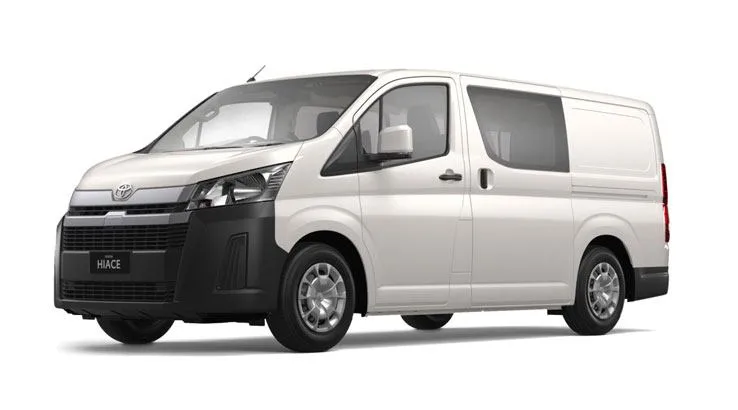Vans form an essential part of the backbone of the economy. When things need transporting from place to place in a fuel-efficient manner and in a relatively compact body, whether it's parcels, tools or materials, nothing does it better than a van. These commercial vehicles offer the best blend of a truck's cargo-carrying abilities with the size and ease of driving an SUV or car. Just like an SUV or car, there are varying sized vans, from compact ones suited to inner-city delivery routes to medium sized models perfect for tradespeople on the tools, right up to large vans with room for complete sheets of plasterboard or wood.
Vans can be outfitted as people movers, as larger minibuses or left as standard for maximum carrying capacity. Even some of the larger models nowadays handle like a much smaller car, making crew cabs particularly practical for tradies who want their van to double as a family car out of work hours. On this page you'll find our time-saving car reviews.
Compare Vans
By clicking "Find a Deal" on the table below, you will be redirected to our partner, OnlineAuto. Thanks to their "bulk buying power", OnlineAuto are able to help you buy the car you want and potentially save you money too. In fact, the average saving through OnlineAuto is $4,616.
What is a van?
The name van is actually short form for caravan. Original vans were covered wagons designed for hauling cargo around behind horses. Later, with the invention of the combustion engine, they became self-propelled. Vans became increasingly popular, with business and government agencies recognising their practicality and utility. With high payloads and interior room, you may have seen specialist conversions like news vans, food and coffee vans or perhaps the most lip-smacking variation, ice cream vans!
Then, of course, there are ambulances which are outfitted to ferry around paramedics and patients, or police vans. There are even companies out there that convert cargo vans into custom campervans and motorhomes, making them the ultimate adventure vehicle.
Benefits and drawbacks
What are the benefits and drawbacks of a van?
Pros | Cons |
|---|---|
| Size. You get a lot more space to carry large goods and tools or to convert into a mobile business. | Fuel economy. There's no escaping it, a fully loaded van will use more fuel than a car, but then you are carrying a lot more goods. How you drive will heavily impact fuel economy. |
| Payload. With no seats, trim and carpets in the back, vans can carry more goods. Some vans can carry well over 1,000kg of stuff! | Size. One of the major advantages of a van, its dimensions, can become a bit of a pain in cities and metro areas. Multi-storey car parks may become a no-go, especially if you have a roof rack fitted. Pay attention to those height barriers! |
| Rugged. If you line the interior of your van with plywood or metal, it'll be able to take a beating. You can throw in a welder, a crate, a euro pallet, heavy tool boxes and the van will shrug it off. | Ride and handling. Although they may feel relatively car-like to drive, they won't handle exactly like a small car. Vans have some heft to them, with uprated suspension, so they do handle quite firmly. |
| Length and height. Van bodies are taller and longer than typical passenger vehicles, meaning you can carry larger items, like baths or building materials, without any problems. | Light rigid class. If you need to move more than 12 adults in your van, you'll need a Light Rigid driving licence. |
| Flexibility. With nothing in the back, you can customise your van heavily. You can also purchase models known as crew or dual cabs, where there's room for up to six passengers. | |
| Body style choices. With so many different body types, including crew cabs, long and short wheelbases and even models with trays, there's a van to suit most businesses. | |
| Roof real estate. Having a long vehicle with a relatively flat roof makes it the ideal place to install roof racks or rails for carrying long, bulky objects like pipes, lengths of timber, ladders or even fishing rods. You can purchase conduit holders to keep copper plumbing pipe safe, or fit a fold-out awning for working underneath. Some roof rack makers produce rollers to make loading and unloading easier. | |
| Surprisingly car-like. Even the largest vans are not that difficult to drive these days. For some, where you're sitting closer to the front wheels, the sensation of turning might be a little different. Also, getting used to having a longer wheelbase could take a bit of adapting, but vans are amazingly car-like to drive in general. Even parking isn't too difficult, though it is helpful to have reverse parking aids. | |
| No extra licence needed. Generally, vans fall below the 4.5-tonne gross vehicle mass that means you need a Light Rigid vehicle licence. This means most people are covered by their Class C "Car" licence, as long as it is not a minibus (with more than 12 seats total). | |
| Discreet. Nothing is as discreet as a plain white panel van. It could contain a priceless work of art, expensive instruments for a musical tour or plain old parcels, but a van doesn't particularly stand out if you want to be less obtrusive. | |
| Room for signage. Those big bodies don't just make vans roomy, they also provide heaps of space for applying stickers and signs to promote your business and give you a really professional brand. | |
| Save on hire costs. Have you been hiring a trailer, van or even paying a courier service on a frequent basis for your business? Buying a van could save you money by enabling you to move the stuff you need to shift in-house. | |
| Environmental impact. Using a van, rather than several smaller vehicles, reduces traffic and there are now several eco-friendly van models on sale. There's even a zero emissions electric van, with a 200km range, in the Renault Kangoo Z.E. Also keep an eye on the Queensland-based EV car maker ACE, which is planning to launch the Cargo this year, as well as electric vans incoming from LDV and Victoria-based Sea Electric PTY Ltd. | |
| Fleet benefits. If you're buying multiple vans, you might get access to fleet benefits like national fleet pricing, bespoke customisation options arranged by the dealer, a fleet specialist account manager, GST and tax bonuses or other corporate benefits. | |
| People movers. People movers and minibuses have extra seats, making them ideal for carrying people long distances from job to job. |
What to look for in a van
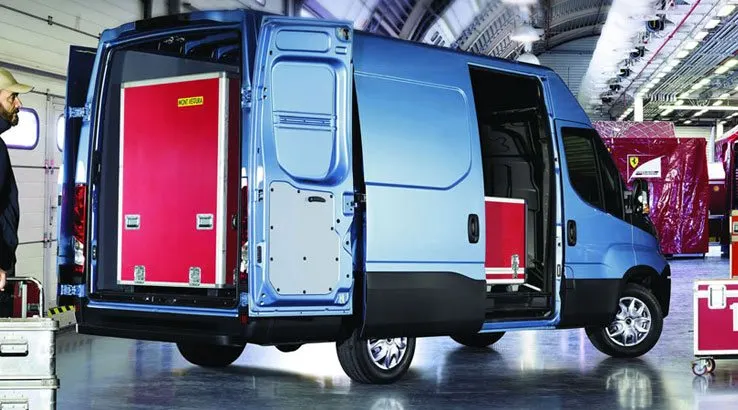
Size
How are you going to use your van? Does it need to be able to carry the most parcels possible? Do you need room to store complete building material sheets? To carry glazing? To be equipped as a mobile food van or wheel repair space, or some other specialist conversion? Thinking about these questions will help you determine how large a van you need.
Tradies might be able to get away with purchasing a smaller, more compact van, while builders and delivery drivers might need larger ones. If you work in a small team, you could need a crew cab. Picking the right size will mean you can save money on fuel economy, but might limit you in the future as to how much stuff you can carry.
Compact vans
- Renault Kangoo
- Citroën Berlingo
- Fiat Doblo
- Peugeot Partner
- Suzuki APV
- Volkswagen Caddy
Medium vans
- LDV G10
- Renault Trafic
- Ford Transit Custom
- Peugeot Expert
- Volkswagen Transporter
- Toyota HiAce
- Mercedes-Benz Marco Polo
- Mercedes-Benz Vito
- Hyundai iLoad
Big vans
- LDV V80
- Ford Transit
- Fiat Ducato
- Peugeot Boxer
- Renault Master
- Volkswagen Crafter
- Iveco Daily
- Mercedes-Benz Sprinter
on OnlineAuto.com.au's website
Roof height
Just like the physical size and wheelbase of your van, the height of the vehicle is important. If it's too tall, you won't be able to enter height-restricted areas. But some businesses need the extra tall body to safely store large glazing panels, sheet building materials or unusually shaped tools. Also, having that extra high roof means you can comfortably walk around in the back of the van without bending over. That will be extremely important if you're wanting to convert the van for use as a mobile workshop or as a food truck.
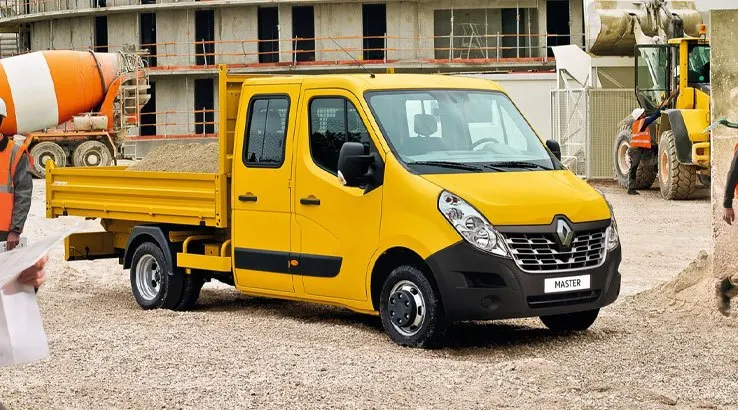
Body style
You might think of them as being a big white panel van, but there are loads of different body styles you can purchase. Obviously, there's the panel van, but these come in many colours to suit your needs. Then there are crew cab versions, with windows and seats in the back, minibuses with more windows and more seats or dual cab (which can seat up to seven) and single cab chassis variants – so you can build a custom back. Some manufacturers offer their chassis cab models with factory trays, while aftermarket specialists can provide a hydraulic bed for recovering and transporting other vehicles.
Then, in the mix, you've got wheelbases. The wheelbase is the measurement between the centre of the two wheels. Longer wheelbases mean there's more room for storage, but that the van will be slightly heavier. Shorter wheelbases make the van better in cities and towns but offer less cargo-carrying capacity.
Transmission and engine
Many vans come with diesel engines, their low-end torque and relative fuel economy proving popular with commercial users, but there are some petrol engine models on sale. Most notably, the HiAce is available with a petrol engine.
Gearbox wise, you can get pretty much whatever you want. There are conventional five-speed and six-speed manuals, right up to eight-speed automatics on the market. If you do a lot of long-distance, higher speed driving, you might want to think about a van with a high number of gears; that way you can drop the engine revs and improve fuel economy. Also, having more gears means you've generally got an optimal ratio first gear for getting moving when fully loaded.
You also need to think about axles and which you'd prefer out of a front-wheel-drive van, a rear-wheel-drive or an AWD. There are dedicated 4x4 vans out there too, with raised ride-heights and better body dimensions for off-roading. See the Iveco Daily 4x4.
Some van makers also produce variants with twin wheel rear axles, so you have four wheels at the rear (two on each side). These are well suited to taking the extra weight of a heavy load or towing a trailer. Typically, these are RWD models, and having two extra tyres at the rear helps with grip on wet grass or in mud.
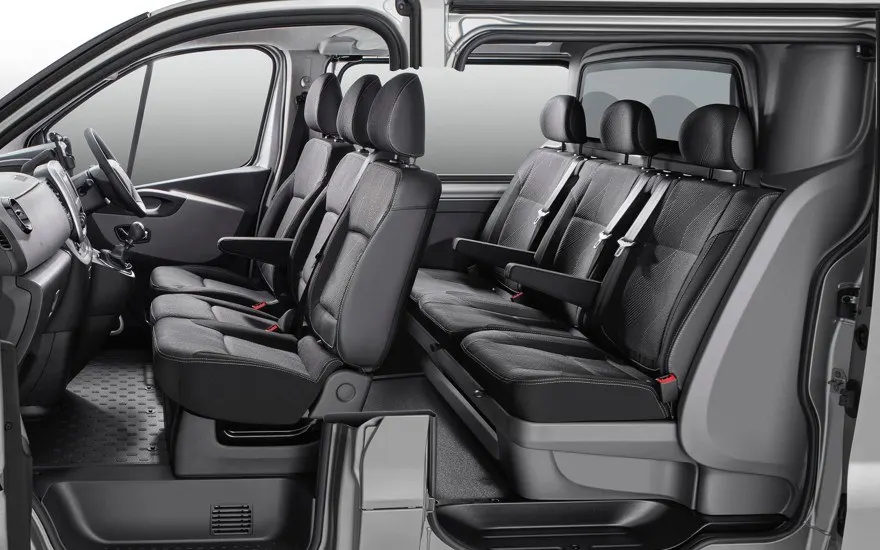
Seating
Many vans only have room for two or three adults. If you need more space for passengers, consider the following vans.
Five-plus seaters
- Toyota Granvia (six or eight seats, van-based people mover)
- Toyota HiAce LWB Crew Van (five seats)
- Hyundai iLoad (six seats available)
- Hyundai iMax (eight seater people mover)
- Ford Transit Custom Double Cab 340L (six seats)
- Ford Transit Double Cab Chassis (seven seats)
- LDV G10 People mover (seven or nine seats)
- Renault Kangoo Crew van (up to five seats)
- Renault Trafic Long Wheelbase Crew Lifestyle
- Renault Master Dual Cab
- Volkswagen Caddy people mover (up to seven seats)
- Volkswagen Caravelle (up to nine seats)
- Volkswagen Crafter Dual Cab Chassis with tray (seven seats)
- Volkswagen Multivan (up to seven seats)
- Volkswagen Transport Dual Cab (six seats)
- Mercedes-Benz Sprinter Dual Cab Chassis (up to seven)
- Mercedes-Benz Vito Crew Cab (up to six)
- Mercedes-Benz Valente (up to nine)
- Mercedes-Benz V-Class (luxury people mover with room for up to eight)
- Mercedes-Benz Marco Polo (seating for five, with beds)
- Iveco Daily Dual Cab (six plus one)
- Toyota HiAce Commuter (12 seats)
- Renault Master Bus (12 seats, including driver)
- Mercedes Sprinter Transfer Minibus (12 seats)
- Iveco Daily Minibus (11, 16 or 22 seaters, plus driver)
- Iveco Daily 4x4 Minibus (up to 14 passengers)
on OnlineAuto.com.au's website
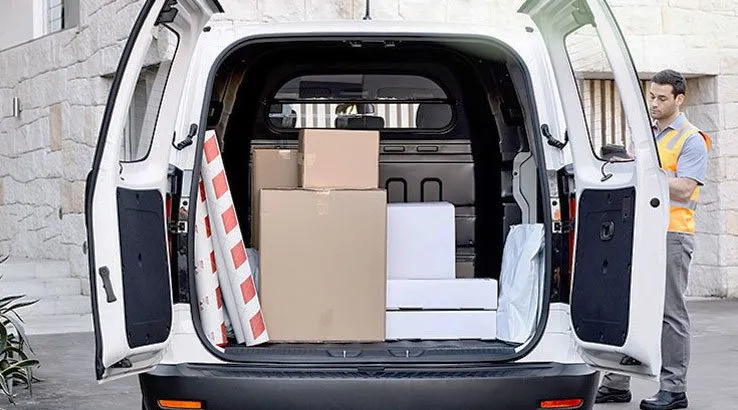
Doors
Next, you need to think about the configuration of doors you're after. Sliding doors on the sides are very common and practical, and they can be opened in parking spaces with little clearance required. The back doors can be split (or barn/twin doors) doors, which usually have the option to open beyond 180 degrees for full access to the van's load bed. Some vans have lifting tailgates; obviously, these need a good amount of overhead room and mean you cannot roll off ladders backwards from the roof.
For the best security and isolation of the cargo area from the passenger cabin, you might choose a van that has a solid bulkhead and no side access doors. Side doors are useful though for couriers and anyone who has a lot of tools in their van, as you can create an area exclusively for things you use the most and not have to clamber over everything in the back.
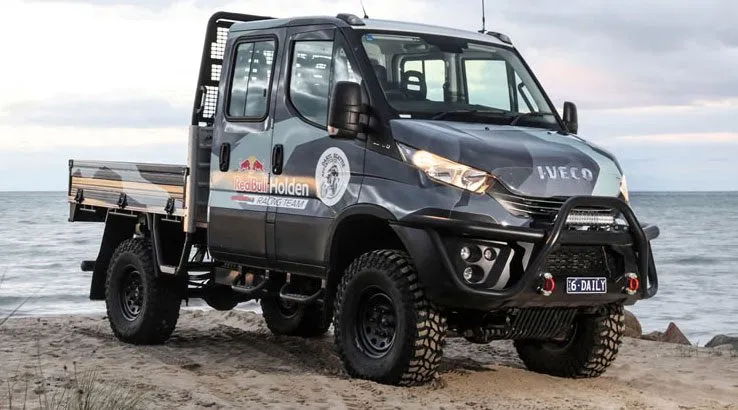
Off-road
Some buyers will require a van that is capable of going onto muddy building sites or up unsurfaced roads. If that's the case, look for manufacturers that produce AWD models. Volkswagen makes 4Motion vans, easily able to tackle construction areas, while Mercedes also builds AWD Sprinters.
However, if you really need a van that is capable of going beyond what even an SUV can take on, you'll want to look at the Iveco Daily 4x4. That thing is an absolute beast, at least in the words of Supercars driver, Shane van Gisbergen.
There's even a minibus version of the Iveco Daily 4x4, which would be perfect for mine/forestry applications and remote construction industries, as well as off-road tours, as a support vehicle or by the emergency services.
Smart technologies
Just because you're buying a van, it doesn't mean you have to forgo passenger safety assists. Many of the currently available vans have features you'd expect to see on modern passenger cars.
The best ones to look out for are:
- Autonomous emergency braking (AEB). Radars or cameras (or a combo of the two) keep monitoring for upcoming obstacles or pedestrians, intervening by deploying the brakes if needed. This goes by many names, including Safety Sense, City Braking, Active City Stop, Collision Mitigation Braking, Smart City Brake Support, PRE-SAFE Brake, Forward Collision Mitigation, Intelligent Emergency Braking, Active City Brake, among others.
- Traffic sign recognition. This detects road signs and relays the information to drivers on the instrument cluster.
- Blind spot monitoring (BSM). Blind spot monitoring makes driving a van much easier, keeping tabs on vehicles and people around you using sensors, then alerting you if you need to take action.
- Parking sensors and rear-view cameras. An absolute must, parking sensors make parking a van a lot easier. It has to be said though, vans are surprisingly easy to get used to. It helps that the back is basically a slab, so you can see the end of the vehicle readily in the mirrors. A reversing camera helps you not only park up but also see if anyone has wandered behind your van unnoticed.
- Adaptive cruise control and speed limiters. Adaptive cruise can lower fatigue on long motorway journeys by maintaining a safe distance between you and the vehicle in front. Speed limiters help stop van drivers getting tickets and stay within the legal limits.
- Other things to keep an eye out for include automatic headlights, rain-sensing wipers, driver alertness monitoring, hill start assist and tyre pressure monitoring.
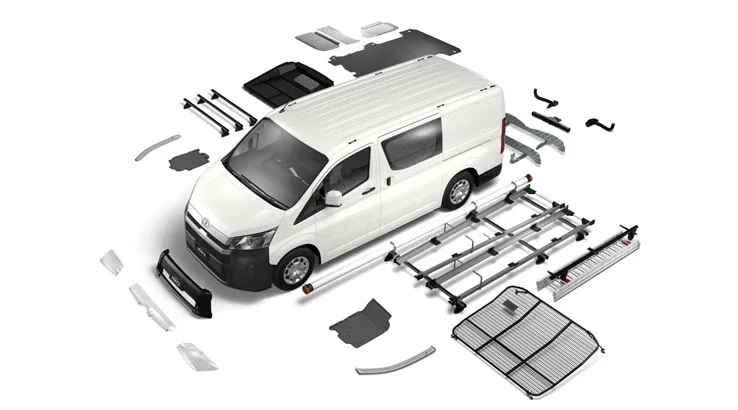
Ply lining and accessories
Don't forget to think about how you can customise your van to suit your business. Ply lining kits are one of the most popular options for panel vans. They enable you to screw pre-cut plywood trim pieces to your van on the floor and sides, protecting the metal bodywork from dings and scrapes. When you're ready to sell the van, you can take them out and reveal the pristine body behind. If you need something more heavy-duty, look for metal lining kits.
There are cargo barriers on sale, that separate the front cab from the rear (if your van doesn't already have one). Factory ones tend to be solid, while aftermarket ones can be made from metal mesh for ventilation.
Shelving is a superb addition, especially for tradies, who often have loads of toolboxes and random fixings. It'll help you work more productively, as you can find what you need while using the space in your van more efficiently.
One of the more common modifications we've come across is creating a false floor, so you can slide full-size work materials and pipes underneath the van floor, and still have space above for storing bulky items or shelving. You can even purchase drawers designed for this use.
Window guards help to secure your tools and any expensive equipment stored in the van.
Seat covers are a must for any profession where you're getting dirty and then need to travel around in your van.
Interior spec
Just because you're buying a van, it doesn't mean you have to miss out on the comforts that ordinary cars commonly have. Vans are closer to cars internally than ever before. You can even purchase models that have higher-end spec lists, like the Transit Custom Sport.
The Ford Transit Custom Sport is a really cool looking van! It's got alloy wheels, racing stripes, a sports body kit, an engine with an increased output and partial leather seat trim. A van like this would suit anyone who wants to stand out a bit, making it an ideal marketing tool, but also well suited to those who travel long distances. If you have a job where you don't get terribly messy at the end of the day, a Transit Custom Sport might suit you. Plus, in the crew cab variant, it can double as a family vehicle.
However, even basic, entry-level vans come with a decent spec. For example, the least expensive Transit Custom has six speakers, an 8-inch touchscreen display, Apple CarPlay and Android Auto, DAB radio, steering-wheel-mounted controls, manual A/C, a leather-wrapped steering wheel, electric windows, power and heated mirrors with side indicators, a heap of driver assists (including front parking sensors), a heated windscreen, an alarm, keyless entry, a digital instrument cluster, an armrest, heated front seats, 10-way driver's seat adjustment and a lot more. That would make some lower-end hatchbacks envious!
Fuel efficiency
Fuel efficiency is a big consideration for business buyers. If you manage a fleet of say 50 vans, if each model is 1l per 100km more economical than a rival van, you're saving 50 litres every 100 kilometres. Those savings quickly rack up!
Comparing the Ford Transit Custom, the Toyota HiAce and Hyundai's iLoad vans on Green Vehicle Guide reveals that the most fuel-efficient of those three is the Transit. Specifically, the Transit Custom 300S Low Roof, which uses 6.5 litres/100km combined, 7.2 in urban driving and 6.1 extra-urban. Aerodynamics, as well as engine selection, will play a huge role here.
Reliability
Look for real-world reviews from verified owners of vans to see how reliable they are. Check over any van forums you can find, seeing if there's a thread on common mechanical faults. According to ProductReview.com.au, the most highly rated van is the Toyota HiAce, with a 3.6 out of 5 satisfaction score from customers. Next is the VW Transporter, followed by the Renault Trafic. The Iveco Daily van scores highly, though it has a low number of reviews.
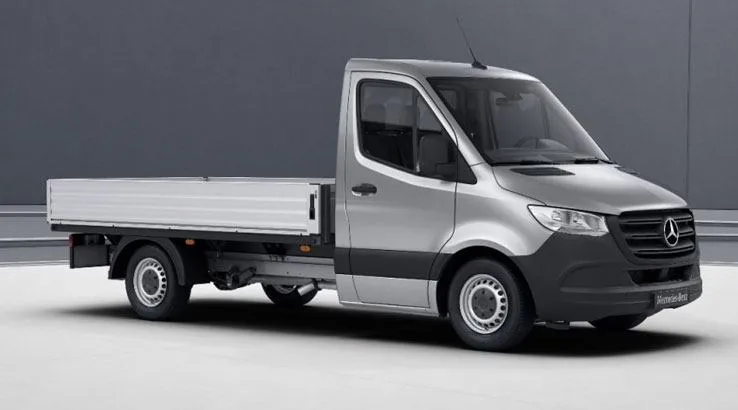
Running costs
Don't forget to look at the running costs. How much are rego and CTP? See if the van you're considering has capped service pricing costs. Find out if your driving would be considered harsh environment use, in which case, you'll need to service the van more frequently. Also, try to remember things like tyres. Vans with more tyres will land you with a larger replacement bill.
Budget
Budget is always the final factor for van buyers. Obviously, you need a vehicle that will fit within your price range. If you've found the perfect model, but it's just beyond what you can afford, there are things you can do.
First, you can compare loans on finder.com.au. We help you save hundreds of dollars between the most expensive and least expensive loans. You can also see the effect of extending the loan period, as this too will lower your monthly payments, though you'll pay back more in interest.
Second, you could try shopping used, whether that be with approved used examples on manufacturer's websites or buying from an online classifieds site. If you go this route, don't forget to investigate pre-approved loans; that way, you know you can get the money and can bargain a more competitive deal.
Third, you could try shopping at a vehicle auction. Buying an ex-council or emergency service vehicle often makes sense. These vans are often extremely well maintained (stringent servicing and in-house mechanics) and come pre-fitted with thousands of dollars of extra features and equipment. The only downside is they'll typically have pretty high odometer readings.
Styling
This isn't such an issue with vans as it would be with a private car, but you still want yours to be presentable and say something about your business. Plus, it is possible to buy a van, like a sports model, that really pops out, especially for automotive electricians, mobile mechanics, sparkies and other trades. Plus, if you're buying several vans, it's nice to have them match with a consistent livery and look across the different vehicles.
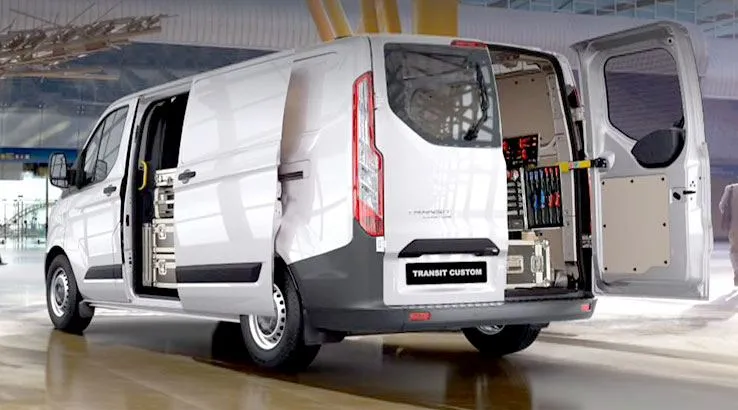
Bestselling vans in Australia
According to VFACTs, published by the Federal Chamber of Automotive Industries (FCAI), the top five selling van models in Australia during 2019 were:
- Toyota HiAce (6,127) – Medium-sized van
- Hyundai iLoad (3,919) – Medium-sized van
- Ford Transit Custom (2,070) – Medium-sized van
- Volkswagen Caddy (1,672) – Small-sized van
- Renault Kangoo (758) – Small-sized van
on OnlineAuto.com.au's website
Mistakes you could make buying a van
Wrong size
If you get too small a van, you'll be constantly scratching your head trying to get everything to fit in the back. If you buy too large a van, you could be spending more than you need to on fuel and having the extra hassle of handling a large vehicle around town.
Wrong doors
You could end up regretting buying a van with a lift-up tailgate if you make deliveries in height-restricted loading bays. Make sure you opt for the right door configuration. If you know what you're doing with the tools and are happy dealing with parts suppliers, you might be able to swap the door set-up, but it's much easier to just buy the van you want in the first place.
Purchasing a trim spec that's too low
Some workhorse-spec vans have a reasonable specification list, but you might miss the higher-end features of slightly more expensive trim grades.
Not having enough seats
It's not always essential, but having a three-seater van is slightly more practical than a two-seater, for those times when you need to take along an extra worker, or just want somewhere to put a laptop or your lunch.
Forgetting to compare finance deals
Not considering all your financing options would be a mistake and one that could hit your wallet. Take a few moments to compare van loans below.
Important: Buying for business?
Did you know that the government recently raised the instant asset tax write-off from $30,000 to $150,000 due to the Coronavirus. Read our guide to the small business tax break and find out if it can help you get that Van.
Image source: Supplied

